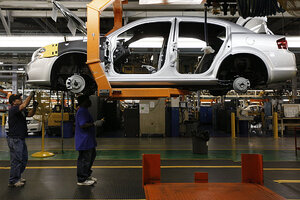Detroit's Big 3 all turn profits in 2010, pulling out of long skid
The Big 3 – GM, Ford, and Chrysler – each reported a profitable 2010. Their collective unit sales rose 19 percent from 2009, one of the worst years ever, as more consumers returned to showrooms.

In this Dec. 6, 2010 photo, line workers assemble a 2011 Dodge Avenger at the Chrysler Sterling Heights Assembly plant in Sterling Heights, Mich.
Paul Sancya/AP/File)
US automakers General Motors, Ford Motor Co., and Chrysler LLC each reported a profitable 2010 Tuesday, with combined unit sales of cars and light trucks topping 5.6 million, a 19 percent increase from the previous year.
The results are expected to help push the automotive industry – domestic and foreign manufacturers selling in the US – to its first profitable year since 2005.
Though year-end numbers were still pending Tuesday from some foreign automakers, total industry vehicle sales in the US are expected to reach 11.5 million units for the year, a 10 percent increase from 2009, which was the worst year since 1982, says Jesse Toprak, vice president of industry trends for TrueCar.com, which tracks vehicle pricing.
The total for 2010 is “still one of the lowest in recent history,” says Mr. Toprak, but the sales improvement indicates that the “cost-cutting measures we’ve seen the industry make in recent years have really worked off handsomely.
“It shows that blindly going after volume in numbers has not worked out for car companies and that profitability should be the ultimate focus,” he says.
Ford and Chrysler shared the largest growth rate last year, jumping 17 percent in unit sales each compared with 2009. GM unit sales increased 7 percent.
Ford credits popular recent models such as the Fusion, a midsize sedan with 219,219 in unit sales last year. The Fusion is the first Ford car since 2004 to break the 200,000-unit barrier. By comparison, Ford sold 528,349 of its F-Series pickup trucks, a 28 percent jump from 2009 levels.
Ford also redesigned and relaunched a couple of retired models. The Taurus, a full-size sedan, increased in sales 51 percent, and the Fiesta, a small car, saw sales rise 7 percent.
GM reported that reducing its stable of brands from eight to four helped it turn a profit for its first full year since its 2009 bankruptcy and subsequent intervention by the federal government. Total sales increased 17 percent to 2.2 million units. Buick was responsible for the highest growth, at 52 percent, while GMC, Chevrolet, and Cadillac all showed improvements.
“Seventeen months ago it could not be business as usual.… Our outlook is quite optimistic. We are looking forward to the new year,” said Don Johnson, vice president of US sales operations for GM, in a teleconference with reporters Tuesday.
Chrysler reported 1.1 million vehicles sold in 2010, crediting a final-quarter push for 16 “all-new or significantly improved models,” Fred Diaz, president of the company’s Ram truck brand, said in a statement. The company’s four brands – Chrysler, Jeep, Dodge and Ram – all generated sales increases over the 12-month period.
US automotive sales have climbed steadily since last year. Total monthly sales of car and light truck sales in the US reached 873,407 units in November, a 17 percent increase compared with November 2009. Several factors have gradually motivated buyers to return to the showrooms, such as pent-up demand and greater spending by dealers on incentives and discounts, analysts say.
Consumers have more clarity now about the economic environment, which they did not have early in the recession, and that is helping them better assess potential risks such as big-ticket purchases, says Toprak. “They’re getting accustomed to uncertainty.… Consumers are now becoming OK with that instead of getting scared” and not buying, he says.
GM's Mr. Johnson predicts that 2011 sales in the US could reach 13.4 million units, though he acknowledges that the US unemployment rate, currently at 9.8 percent, and the uncertain housing market remain obstacles to robust sales, at least as 2011 begins.
“The job market is improving, albeit slowly,” he says. “But we expect the depressed housing market and slow employment growth to somewhat drag on US vehicle sales.”
